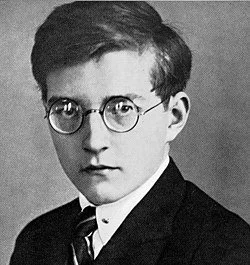Dmitri Shostakovich
Lady Macbeth of Mzensk
Symphony No. 5
Dmitri Shostakovich
1906–1975
String Quartet No. 8
Cello Concerto No.1
Dmitri Shostakovich: Life and Music
Dmitri Shostakovich (1906–1975) was one of the most important Soviet composers of the 20th century. His music tells a story not only of talent and creativity but also of fear, survival, and hidden messages. Living under Joseph Stalin’s (Soviet dictator) rule, Shostakovich had to balance writing powerful music with staying safe in a system that punished artists who stepped out of line.
In this article, you’ll read about Shostakovich’s life, some of his most famous works, and the stories behind them.
Early Success and First Symphony
Born in St. Petersburg, Russia, Shostakovich showed musical talent at an early age. He studied at the Petrograd Conservatory, and at only 19 years old, he wrote his First Symphony (1925). The piece was an instant success and launched his career out globally.
You might think that Shostakovich sounds like a very precocious composer, but his early fame also brought him danger. In the Soviet Union, every piece of music was judged by whether it supported the organization’s values.
Lady Macbeth and Stalin’s Wrath
In 1934, Shostakovich premiered the opera Lady Macbeth of Mtsensk. At first, it was praised for its intensity and originality, but when Joseph Stalin attended a performance in 1936, he hated it. Soon after, the Soviet newspaper Pravda published an article calling the opera “muddle instead of music.”
This public attack was terrifying for Shostakovich. Fearing for his safety, he withdrew his Fourth Symphony before its premiere.
The Fifth Symphony: An Attempt to Change His Fate
To try and repair his reputation, Shostakovich wrote his Fifth Symphony (1937). It was introduced as “a Soviet artist’s response to just criticism.” On the surface, it sounded heroic and patriotic, pleasing the authorities. But many listeners interpreted the ending as sarcastic. Sounding like a forced celebration under pressure.
This musical irony became one of Shostakovich’s trademarks.
The Leningrad Symphony
During World War II, Shostakovich became a symbol of Soviet resilience. While Leningrad (St. Petersburg) was under siege, he composed his Seventh Symphony, known as the “Leningrad.”
In 1942, the symphony was performed in the starving city of Kuibyshev by musicians so weak that some had to be carried onto the stage. The performance was broadcast worldwide and became a powerful symbol of resistance against Nazi Germany.
Music with Hidden Messages
Not all of Shostakovich’s works were written for big audiences. Some of his most personal music appears in his string quartets.
String Quartet No. 1 (1938): Writing his first string quartet brought him more interest in the idea of chamber music and led him to write a total of fifteen quartets. In his first quartet, he heavily reflects on his youth, putting in happy and joyful tunes to represent the timeless era of childhood.
String Quartet No. 8 (1960): Dedicated “to the victims of fascism and war,” but widely believed to be about Shostakovich himself. It uses his musical signature (DSCH: D–E♭–C–B) and quotes his earlier works, making it deeply autobiographical.
Symphony No. 10 (1953): Written after Stalin’s death. Many believe the violent second movement represents Stalin’s cruelty, while the finale shows Shostakovich’s relief of surviving his wrath.
Final Years and Legacy
In his later years, Shostakovich wrote more reflective works, including:
Symphony No. 14 (1969): A dark meditation on death, using poems as text.
Symphony No. 15 (1971): His final symphony, filled with strange quotations and humor.
String Quartet No. 15 (1974): His final string quartet, and one of his most reflective ones.
He died in 1975, leaving behind 15 symphonies, 15 string quartets, operas, film scores, and concertos.
Today, Shostakovich is remembered not only as one of the greatest composers of the 20th century but also as an artist who used music to express truth and survive in dangerous times. When most people think of Shostakovich, they just think of him as another famous composer. But now you've learned the allegory of his life and more personal details of his background. Thanks for reading! Yours truly, Kenny Zhang
Works Cited
1.“Dmitri Shostakovich.” Wikipedia, Wikimedia Foundation, 2025.
https://en.wikipedia.org/wiki/Dmitri_Shostakovich
2.“Dmitri Shostakovich.” Chamber Music Society of Lincoln Center.
https://www.chambermusicsociety.org/about-the-music/composers/dmitri-shostakovich/
Written by Kenny
